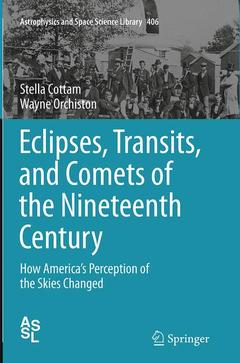Description
Eclipses, Transits, and Comets of the Nineteenth Century, 2015
How America's Perception of the Skies Changed
Astrophysics and Space Science Library Series, Vol. 406
Authors: Cottam Stella, Orchiston Wayne
Language: English
Subjects for Eclipses, Transits, and Comets of the Nineteenth Century:
Keywords
19th Century Media Coverage; 19th Century Solar Eclipses; American Astronomy History; American Astronomy History; Historical Media Coverage of Astronomy; History of Popular Astronomy; Popularization of Astronomy; Public Reaction to Astronomy; Reaction to Discovery of Neptune; Transit of Venus
105.49 €
In Print (Delivery period: 15 days).
Add to cartPublication date: 08-2016
Support: Print on demand
Approximative price 105.49 €
In Print (Delivery period: 15 days).
Add to cartPublication date: 09-2014
336 p. · 15.5x23.5 cm · Hardback
Description
/li>Contents
/li>Biography
/li>Comment
/li>
Introduction.- Historical Overview- The United States and Astronomy Until the 1860S.- Scientific Overview.- Popular Astronomy and the Solar Eclipses of 1868, 1869 and 1878.- Popular Astronomy and the Transits of Venus of 1874 and 1882.- Discussion.- Concluding Remarks.- References.
These books may interest you

Exploring the History of New Zealand AstronomyTrials, Tribulations, Telescopes and Transits 158.24 €



